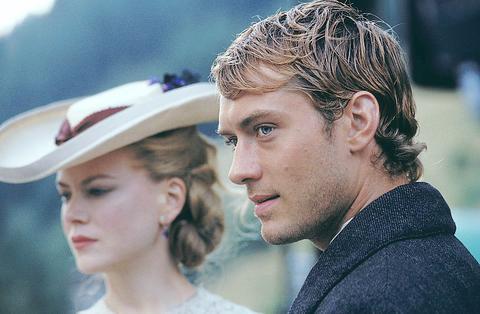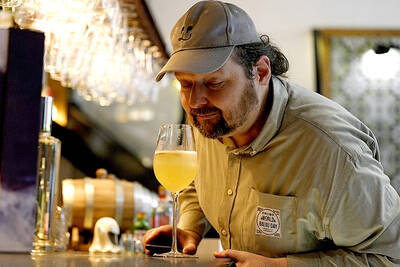Were it not for a gruesomely violent battle sequence at the beginning, a smattering of profanity and an occasional glimpse of unclothed flesh, Cold Mountain might easily be mistaken for the product of an earlier era of movie-making. The film, freely adapted by Anthony Minghella from Charles Frazier's best-selling novel, is an episodic romance that begins like a war movie and ends like a western, and it requires an old-fashioned critical idiom to do it justice. It is, as my predecessor Bosley Crowther might have said, one heck of a classy picture.
I mean this both as sincere praise and as a qualification of that praise. Cold Mountain, at once generous and self-congratulatory, full of lush scenery and large emotions, clearly longs for a home on the video store's classics shelf. To speed its passage, it arrives laden with the trappings of prefabricated cultural prestige, including a high-toned literary pedigree and a lustrous cast of past and future Oscar winners and nominees. The film, opening nationwide today, thus follows in what has become a Miramax tradition of highly polished, and often lifeless, literary adaptations, including The English Patient (also directed by Minghella), The Cider House Rules and Chocolat.
Fortunately, Cold Mountain, which stars Jude Law and Nicole Kidman as would-be lovers separated by the cruelty and privation of the American Civil War, distinguishes itself from such middlebrow conversation-stoppers. Its sober good taste is enlivened by large doses of intelligence and humor, and even a touch of authentic cinematic grandeur.

By authentic I mean utterly artificial. Minghella, who can be overly solemn in pursuit of realism, is, thank goodness, also entranced by the beauty of exotic landscapes and the charisma of movie stars. Kidman, playing Ada Monroe, a citified preacher's daughter stranded in the remote hamlet of Cold Mountain, North Carolina, has never been lovelier, and her radiance at once challenges your disbelief and compels you to suspend it. Even dressed in cast-off men's clothes and struggling against the rigors of 19th-century rural life, she looks as if she had stepped from the pages of a glossy magazine, her eyebrows and cuticles painstakingly attended to. This incongruity adds to the movie's charm rather than dispelling it.
And in nearly every particular -- including the soundtrack, which blends Gabriel Yared's lavish symphonic orchestration with Appalachian fiddle breakdowns and Deep-South Sacred Harp vocal harmonies -- the movie's elegant fakery improves on the book's stiff pretentiousness. The gothic landscape of Romania (beautifully photographed by John Seale) stands in for the hills and hollows of western North Carolina, and the plain country people who inhabit the novel's mock-folksy episodes are impersonated onscreen by a platoon of well-respected actors, many of them British, who drawl their vowels and clip their consonants into approximations of Southern American dialect.
Law's accent is probably the most convincing, and his matinee-idol features are, for much of the movie, camouflaged by grime, fatigue and an unkempt beard. One peculiarity of Cold Mountain is that it is a love story in which the two romantic leads share little screen time and often seem to inhabit separate movies. In early flashbacks, Ada and Inman, Law's wry, taciturn character, trade flirtatious glances and share a rushed farewell kiss, but mostly they are apart, clinging to the dim prospect of reunion as a survival strategy.
The story's pathos comes from the disproportionate intensity of their longing. They barely know each other, and their love is an attempt to conjure an idea of happiness in grim times.
Inman, wounded in the battle of Fredericksburg, steps out of the window of a squalid Virginia military hospital and undertakes a long inland trek toward home. Ada, after the death of her father (Donald Sutherland), must contend with a harsh lifestyle for which her cosseted upbringing has left her unsuited. To help Ada manage her father's sprawling farm, her neighbor, Sally (Kathy Baker), sends over a no-nonsense spitfire named Ruby (Renee Zellweger), instigating a friendship that becomes the film's central relationship.
Zellweger, wild-haired and ornery, clomps through the scenery like a migrant from Li'l Abner's Dogpatch. Her earthiness warms up Cold Mountain considerably, and her scenes with Kidman have a loose, improvisatory rhythm missing from much of the movie. They work together like a seasoned comedy team, and Minghella makes the most of their differences in temperament and appearance.
While Ada grapples with farm work and the unwelcome attentions of Teague (Ray Winstone), an officer in the Home Guard who terrorizes the people of Cold Mountain in the name of the faltering Confederate cause, Inman slogs through a landscape populated by figures out of old murder ballads and tall tales.
Law, a hint of mischief lingering around his tired eyes, meets up with a parade of Hollywood hillbillies, including Philip Seymour Hoffman, Natalie Portman, Giovanni Ribisi and Eileen Atkins. (Among the very few black people he sees is a silent, briefly glimpsed band of runaway slaves.) Alternating between these encounters and Kidman' s home-front stoicism, Cold Mountain unfolds in lyrical counterpoint.
Its awkward beginning -- a jumble of flashbacks, voice-overs and confusing combat scenes -- reveals the structural challenge Minghella faced in adapting the novel, which seesaws between the present and the past and includes numerous digressions and side narratives. Imitating it too faithfully would have killed the film's fragile momentum, but Minghella, working with the matchlessly resourceful editor Walter Murch, has tightened Frazier's ungainly tale while preserving its epic capaciousness.
The result is a mountain of honest, nourishing corn, a lavish evocation of simplicity that, for all its showy sophistication, has an appealing emotional directness. For all its sweep and scope and movie-star magic, Cold Mountain is studded with fine small moments and deft supporting performances, notably from Atkins, Portman and Brendan Gleeson, who plays Ruby's wayward, fiddle-playing father.
The final assault on the heartstrings is marred only by the inevitable sex scene, a concession to modern sensibilities that makes you long for the old days of Production Code repression, when instead of a few minutes of peekaboo montage and heavy breathing, Inman and Ada would have consummated their love with a blown-out candle, a closed door, and a few wispy clouds suggestively passing across the moon.

The unexpected collapse of the recall campaigns is being viewed through many lenses, most of them skewed and self-absorbed. The international media unsurprisingly focuses on what they perceive as the message that Taiwanese voters were sending in the failure of the mass recall, especially to China, the US and to friendly Western nations. This made some sense prior to early last month. One of the main arguments used by recall campaigners for recalling Chinese Nationalist Party (KMT) lawmakers was that they were too pro-China, and by extension not to be trusted with defending the nation. Also by extension, that argument could be

Aug. 4 to Aug. 10 When Coca-Cola finally pushed its way into Taiwan’s market in 1968, it allegedly vowed to wipe out its major domestic rival Hey Song within five years. But Hey Song, which began as a manual operation in a family cow shed in 1925, had proven its resilience, surviving numerous setbacks — including the loss of autonomy and nearly all its assets due to the Japanese colonial government’s wartime economic policy. By the 1960s, Hey Song had risen to the top of Taiwan’s beverage industry. This success was driven not only by president Chang Wen-chi’s

Last week, on the heels of the recall election that turned out so badly for Taiwan, came the news that US President Donald Trump had blocked the transit of President William Lai (賴清德) through the US on his way to Latin America. A few days later the international media reported that in June a scheduled visit by Minister of National Defense Wellington Koo (顧立雄) for high level meetings was canceled by the US after China’s President Xi Jinping (習近平) asked Trump to curb US engagement with Taiwan during a June phone call. The cancellation of Lai’s transit was a gaudy

The centuries-old fiery Chinese spirit baijiu (白酒), long associated with business dinners, is being reshaped to appeal to younger generations as its makers adapt to changing times. Mostly distilled from sorghum, the clear but pungent liquor contains as much as 60 percent alcohol. It’s the usual choice for toasts of gan bei (乾杯), the Chinese expression for bottoms up, and raucous drinking games. “If you like to drink spirits and you’ve never had baijiu, it’s kind of like eating noodles but you’ve never had spaghetti,” said Jim Boyce, a Canadian writer and wine expert who founded World Baijiu Day a decade